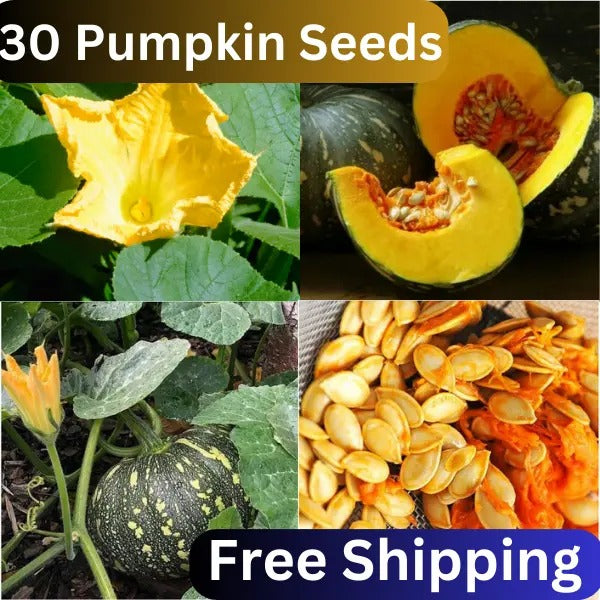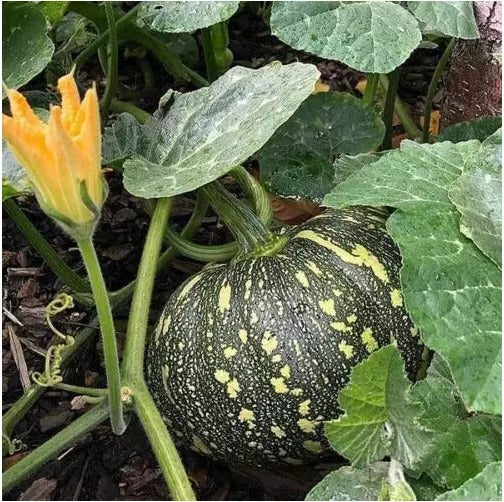Senci Green Garden
Pumpkin Organic Heirloom Ceylon 30 Seeds (Cucurbita pepo) NON-GMO FRESH
Pumpkin Organic Heirloom Ceylon 30 Seeds (Cucurbita pepo) NON-GMO FRESH
Couldn't load pickup availability
Pumpkin Organic Heirloom Ceylon
30 Seeds
Cucurbita pepo, commonly known as pumpkin, is a species of squash that belongs to the gourd family Cucurbitaceae. This species includes a wide variety of cultivars such as pumpkins, zucchinis, and summer squashes.
Botanical Description
Scientific Name: Cucurbita pepo
Family: Cucurbitaceae
Common Names: Pumpkin, field pumpkin, summer squash, zucchini, courgette
Origin: Native to North America
Physical Characteristics
Growth Form:
Habit: Annual herbaceous plant that grows as a vine or bush. Vines can extend to several meters in length.
Stem: The stem is angular and typically covered with fine, prickly hairs.
Leaves:
Shape: Large, heart-shaped to pentagon-shaped, with serrated edges and deep lobes.
Size: Can reach up to 30 cm (12 inches) across.
Texture: Rough and hairy surface.
Flowers:
Type: Monoecious, meaning it has both male and female flowers on the same plant.
Appearance: Bright yellow to orange, funnel-shaped flowers. Male flowers appear first and are on long, slender stalks, while female flowers have a swollen base that will develop into the fruit.
Fruit: Shape: Varies widely from spherical to oblong to flattened, depending on the cultivar.
Size: Ranges from small (a few centimeters in diameter) to very large (up to 100 cm or more in diameter).
Color: Commonly orange, but can also be yellow, green, white, or striped.
Texture: Smooth to ribbed, with a thick, hard rind.
Seeds: Flat, oval seeds with a white outer coating, contained within a fibrous, pulpy interior.
Cultivation
Climate: Prefers warm climates with temperatures between 18-30°C (65-85°F). Sensitive to frost.
Soil: Thrives in well-drained, fertile soils rich in organic matter with a pH between 6.0 and 6.8.
Propagation: Grown from seeds. Seeds are typically planted directly in the ground after the last frost date in spring.
Growth Requirements: Requires full sun and ample water, particularly during fruit development.
Uses
Culinary:
Fruit: Used in soups, stews, pies, and other dishes. The flesh is often cooked and pureed.
Seeds: Edible and can be roasted as a snack. Also used to produce pumpkin seed oil.
Flowers: Can be used in cooking, often stuffed or battered and fried.
Nutritional Value: Rich in vitamins (especially vitamin A), minerals, and antioxidants. Low in calories and high in fiber.
Medicinal: Used in traditional medicine for its anti-inflammatory and antioxidant properties. Seeds are known for their potential benefits for prostate health and urinary conditions.
Ornamental: Often used as decorations, especially during the autumn season and Halloween, when pumpkins are carved into jack-o'-lanterns.
Varieties
Pumpkins: Typically round and orange, used for pies and decoration.
Zucchini: Long, cylindrical, and green or yellow, used as a vegetable in cooking.
Summer Squashes: Varied shapes and colors, harvested immature and tender.
Economic Importance
Agriculture: Widely grown for food, oil, and ornamental uses. An important crop in many countries.
Cultural Significance: Prominent in North American festivals like Halloween and Thanksgiving.
Challenges
Pests and Diseases: Susceptible to pests like squash bugs, cucumber beetles, and diseases such as powdery mildew and downy mildew.
Climate Sensitivity: Sensitive to frost and extreme weather conditions, which can affect yield.
Cultural Significance
History: Cultivated for thousands of years by indigenous peoples of the Americas. Played a crucial role in the diet of Native Americans and early settlers.
Festivals and Traditions: Integral to autumn celebrations, particularly in North America. Pumpkins are a symbol of harvest time and are central to activities like pumpkin carving and pie baking.
Cucurbita pepo is a versatile and economically significant species with diverse uses ranging from culinary applications to cultural traditions. Its adaptability and wide range of cultivars make it a valuable crop worldwide.
Share






















